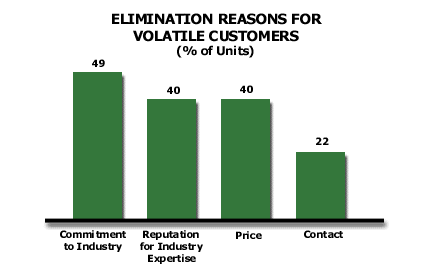Analysis 32: Elimination Reasons for Volatile Customers
EXHIBITS:

| HOW TO INTERPRET THE ANALYSIS: This exhibit rank orders the key reasons that volatile customers, those changing suppliers, gave for eliminating potential suppliers in the marketplace. The total of all the bars adds to a number greater than 100 because customers often listed several reasons for elimination of a competitor. Of all the units lost during the occasions of elimination, 49% of the total volume opportunity that was lost by competitors was due to commitment to the industry. This means that the customer viewed the competitor as not being as committed the development and technology of the industry as were other competitors in the marketplace. Nearly 40% of the units available in volatile situations eliminated potential suppliers due to high price. This suggests that there were significant price differences among competitors for similar products. In order to avoid elimination, the company would be wise to assure itself that the customers in the industry see it as committed to the industry, as expert in the industry and as competitively priced because failing on these measures cause significant competitor elimination from volatile customers' consideration.
PURPOSE: This analysis provides rank ordered reasons that customers use to eliminate potential suppliers for any position in their relationship. The company uses this analysis as one of several to improve its odds of avoiding elimination when volatile customers seek new suppliers. APPROACH: This analysis requires customer interviews of some of the customers who changed suppliers during the period under analysis. For each customer interview, the company records the amount of volume that changed suppliers and all the reasons the particular customer used to eliminate potential suppliers in his buying process. Elimination occurs at any one of three levels: invitation to bid; preliminary review; and final detailed evaluation. The company then assigns the customers' volume to each reason given and then divides the unit volume by reason by the total volatile volume in the marketplace. This enables the company to rank order each reason. The company uses this analysis to determine part of the priority of needs it has for its product and service innovations. A better analysis for the company would rank order each of the company specific reasons for potential volume loss (see Analysis 33). For further description of how to use market data to develop performance innovations see Analysis 35. Return to Diagnose Products and Services: Negative Hidden Volatility |
|
Recommended Reading |
| For a greater overall perspective on this subject, we recommend the following related items:
Analyses:
Symptoms and Implications: Symptoms developing in the market that would suggest the need for this analysis. Perspectives: Conclusions we have reached as a result of our long-term study and observations.
|
